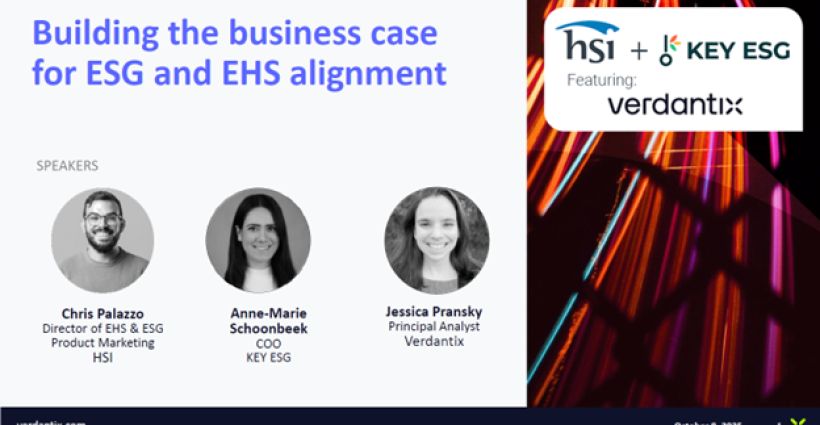Expert Insights from Verdantix | For a Smarter, Safer Future

In October 2025, HSI and KEY ESG co-hosted a webinar with Verdantix for a live discussion on how organizations can benefit from ESG and EHS alignment. The session brought together Jessica Pransky (Verdantix Principal Analyst), Christopher Palazzo (HSI Director of Product Marketing), and Anne-Marie Schoonbeek (KEY ESG COO & Co-Founder) to share research insights, practical examples, and emerging technology trends shaping sustainability strategy.
A Shifting Regulatory Landscape
The conversation opened with Verdantix’s latest data from their 2025 Global Corporate Survey: ESG & Sustainability Budgets, Priorities and Tech Preferences.
This year has been a year of rapid regulatory change, with both stateside and European regulators making several key adjustments to their regulations:
- In the U.S., federal climate-disclosure rules have been rolled back, shifting responsibility to state-level mandates. California’s SB 253 and SB 261 now require large firms to disclose Scopes 1–3 emissions and climate-related financial risks, with penalties reaching $500,000 per year.
- In Europe, the EU Omnibus Proposal aims to streamline sustainability directives such as the CSRD, delaying deadlines but expanding expectations for data quality.
- Across APAC, countries like Japan, Singapore, and Australia are adopting ISSB-aligned disclosure standards.
Despite the uncertainty, Verdantix research shows that over half of global firms are maintaining or increasing their ESG budgets, reframing sustainability as a lever for operational resilience and risk management, not merely compliance.
Why EHS and ESG Integration Matters
Data remains the defining challenge for both EHS and ESG leaders. Verdantix’s 2025 Global Corporate Survey identifies poor data collaboration and fragmented ownership as top obstacles to credible reporting.
How Aligning EHS and ESG Functions solves the Data and Collaboration Challenge
Aligning EHS and ESG functions does more than improve communication — it directly addresses the root causes of unreliable reporting and disconnected operations. By bringing these disciplines together, organizations can:
- Create a single, traceable source of truth for environmental, health, and safety data - ensuring every metric is consistent, comparable, and auditable.
- Build confidence in investor-grade reporting through standardized data formats, automated audit trails, and transparent ownership across teams.
- Strengthen collaboration across departments - bridging the gap between operations, sustainability, and finance to ensure that compliance, performance, and strategy are all informed by the same reliable dataset.
As Jessica Pransky explained:
“A lot of sustainability data comes from so many different places - different systems, sensors, and teams - that it becomes really hard to ensure consistency and traceability. Having a central repository and software that standardizes formats across functions allows multiple people to access the data with visibility and audit trails.”
She continued:
“In short, integration helps organizations move from fragmented, reactive reporting toward cohesive, insight-driven sustainability management, turning compliance challenges into strategic opportunities.”
KEY ESG’s Lessons from the Field
Anne-Marie Schoonbeek shared two examples of successful alignment between EHS and ESG functions using KEY ESG’s sustainability software:
- Wittur Group (Manufacturing): Automated data collection across 50 countries, reducing manual workflows and empowering local EHS champions to manage carbon accounting and regulatory readiness.
- Babilou Family (Childcare & Education): Unified ESG and operational KPIs across 1,200 sites, cutting reporting time by 50 % and enhancing visibility for improvement initiatives.
Both case studies demonstrate how building a repeatable and scalable process around data aggregation and reporting drives efficiency and engagement. In both these cases, the software platform enabled centralised visibility and local accountability
Technology as the Enabler
Verdantix’s latest survey shows that firms are rapidly moving away from spreadsheets toward integrated sustainability platforms. Over 80 % now use dedicated ESG/EHS software, correlating with a 10-point rise in confidence around data accuracy and auditability.
Unified systems deliver measurable business benefits:
- Centralized, automated data flows
- Lower reporting costs and human error
- Improved stakeholder trust and visibility
- Better resource optimization and risk management
Artificial Intelligence is also emerging as a key tool for data aggregation, predictive analytics, and performance tracking, provided that governance and ethical safeguards are in place.
Key Takeaways
- Regulatory change is constant - preparation is progress.
Compliance requirements will evolve, but robust data systems endure. - EHS + ESG alignment multiplies impact.
Shared data and objectives create efficiency and consistency. - Technology underpins trust.
Automated systems strengthen credibility with investors and regulators. - Employee engagement turns compliance into culture.
Empowered teams make sustainability part of daily operations.
In Conclusion
The webinar discussion surfaced many insights around the benefits of EHS and ESG alignment. Building on data from Verdantix’s Global Corporate Survey and live case studies from KEY ESG’s client base revealed one principal learning: organizations that connect compliance, safety, and sustainability within one unified data ecosystem are best positioned to meet regulatory demands, strengthen resilience, and deliver measurable value.
Please find the full webinar recording available for download here.


